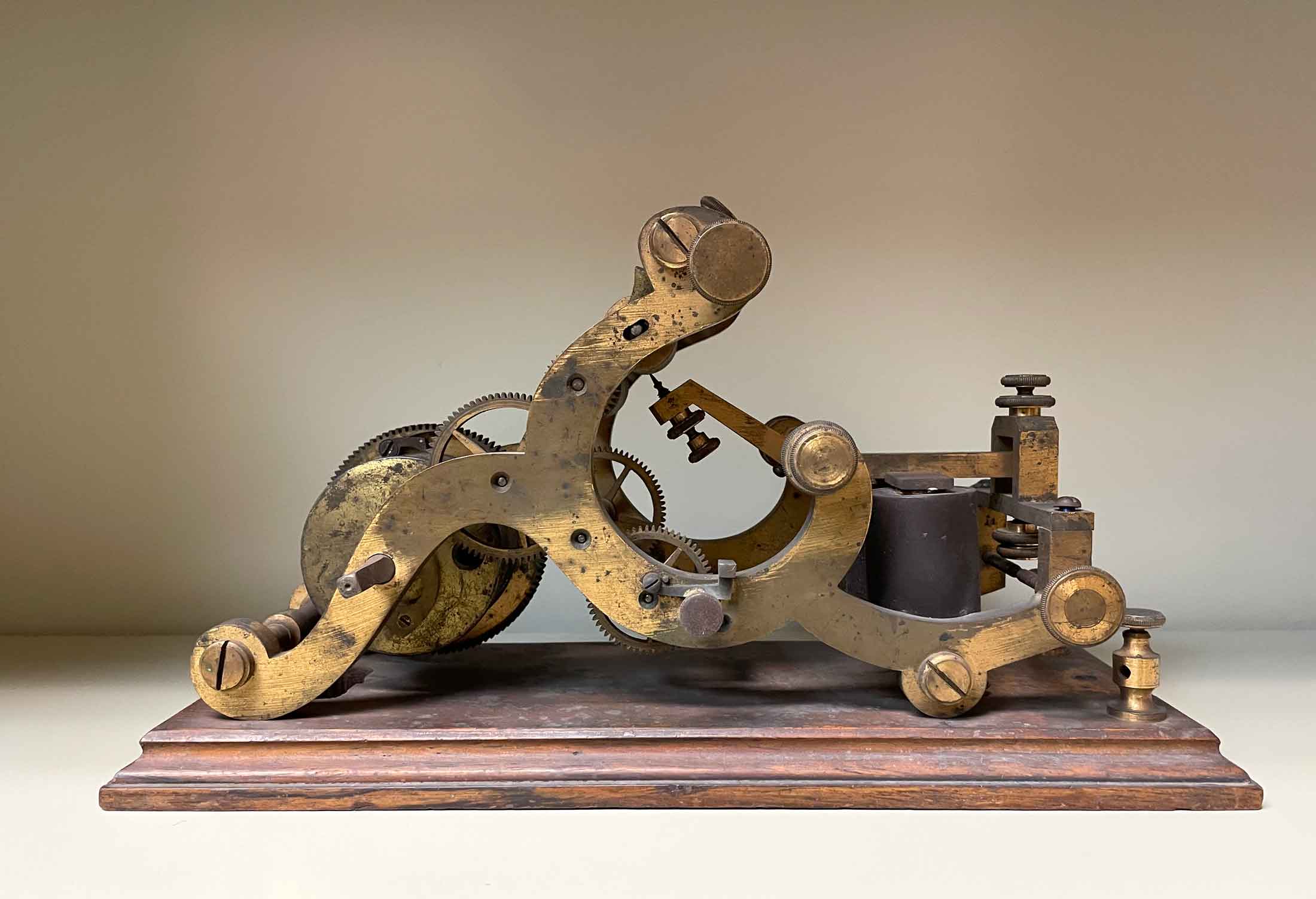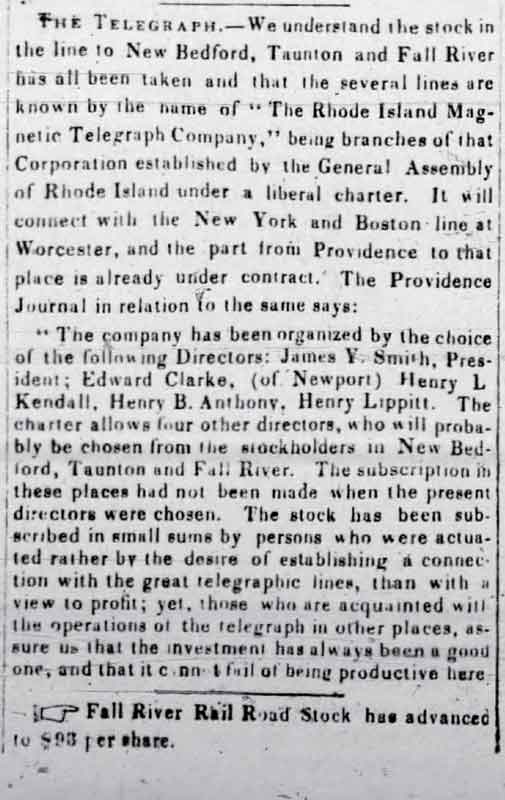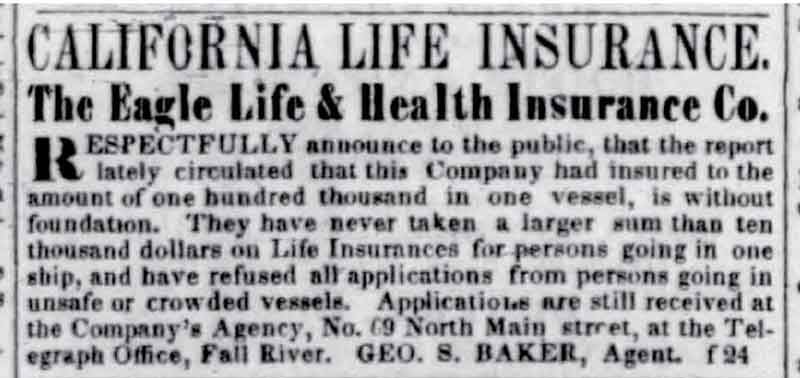Treasures in the Collection at the Fall River Historical Society
As we go about packing and moving the Fall River Historical Society holdings for the installation of the new HVAC system, we are rediscovering myriad art and artifacts in the treasure trove that is the museum collection.
Many of these historically significant items have not seen the light of day in decades, and most will require some form of conservation to ensure their preservation for future generations.
Join us on this fascinating voyage of discovery as we delve into Fall River’s rich history and uncover the untold stories of these important artifacts that document our cultural heritage.
We add to this online collection periodically, so check back often for more content. There are currently two listings below.

Morse Telegraph Recording Register, c. 1848.
Material: Wood, brass, copper
Dimensions: 12" x 4 5/8" x 6 ¾"
Object ID #: 1936.21.1
This important artifact is the “First universal telegraph instrument used in Fall River.” This device had an astounding impact on the town of Fall River, connecting it, via wire, to the rest of the country, and soon to the world.
This register was donated to the FRHS in 1936 by William Arnold Harris (1848-1937), who by 1870 was employed as a telegraph operator in Providence, Rhode Island. His maternal uncle, William P. Potter (1832-1906) was “the first manager of the Fall River Office of the Western Union Telegraph Company.”
Thomas Richmond Burrell Sr. (1861-1953), writing in his Main Street in the Eighteen Seventies and Eighties, gives us a colorful description of Potter:
William P. Potter … had an extra little finger on his right hand. This was very conspicuous when he was engaged in sending and receiving messages and, if a boy had a visitor from the country, it was a great stunt to take him to the telegraph office and show him Mr. Potter’s extra digit.
It is possible the instrument passed into the donor’s possession via his Uncle William.
Artist and inventor Samuel Finley Breese Morse (1791-1872) perfected a communication method to send electronic signals through wires. In 1844, Morse had a telegraph line installed from Washington D.C to Baltimore, Maryland, where the Democratic National Convention was being held. He wanted to demonstrate the importance of his invention by sending news from the convention to the nation’s capital in real time. The demonstration was a resounding success, ushering in a new age of communication.
Fall River, like the rest of the country, took note.
From the Fall River Monitor, November 27, 1847:
Telegraph Line. — We learn from good authority, that a Telegraphic Line is to be opened from New Bedford to Fall River, thence to Taunton, thence to Providence, and from Providence either to Worcester or Boston, probably to Worcester. In either case, this will open a Telegraphic communication which will be highly important to our citizens. The stock, we are informed, has been nearly, and probably ere this, all taken — The line will, in all probability be in operation by the first of January next.
Fall River Monitor, Dec. 11, 1847:

Fall River Monitor, Jan. 1, 1848:
The posts are all erected for the Providence and Worcester Telegraph, and a part of the wire has been placed. The workmen are making very good progress on the New Bedford, Taunton, Fall River and Providence line.
Fall River Monitor, Jan. 15, 1848:
A meeting of the Stockholders of the Magnetic Telegraph Co. in this place, was holden at the Office of J[ames] Ford on Tuesday evening last. N[athaniel] B[riggs] Borden was chosen Chairman and N[athan] Durfee Secretary of the meeting. Messrs. N[athan] Durfee, G[eorge] S[eymour] Baker and G[uilford] H. Hathaway were appointed a Committee to select a suitable location and contract for the Office of the Company in Fall River. It is expected that the Telegraph will be in operation by the first of February, next.
Astute Fall River investors purchased shares in the new company as rapidly as Fall River citizens and businesses began utilizing this new method of communication.
Fall River Monitor, March 24, 1849:

Arthur Sherman Phillips (1865-1941), in Fascicle II of his Phillips History of Fall River, wrote about the city’s telegraph companies:
In 1853, “The New York and Union Company” took over the Rhode Island lines, connecting Providence with Worcester, Bristol, Taunton, Fall River and New Bedford. In the Fall River Directory of 1855, an advertisement of this company locates the office in Sec. G., Granite Block with W. P. Potter as operator. There was also the Newport and Fall River Line at 17 North Main Street with George W. Dougherty as operator.
Fall River with its cotton and cloth business provided considerable revenue for telegraph companies and by 1885 there were four companies doing business here: The “Baltimore and Ohio,” “Mutual Union,” “United Lines,” and “Western Union.” The Western Union Telegraph Company was given legal birth in 1857 and by degrees absorbed all competitors in this region with the exception of the Postal telegraph Company organized in 1881, which located an office in Fall River in 1888. The “Mutual Union” had an office here as late as 1889 but from 1890 on, only the “Western Union” and the “Postal” remained.
The advent of the telegraph age and the first rapid means of long-distance communication to and from Fall River was enabled by the device depicted here. It is a rare survivor and an important historical object.
It has been preserved in remarkable condition, but dust, soiling, and areas of surface degradation are evident throughout, and conservation is required. It will be necessary to obtain a conservation assessment from a specialized conservator to identify condition issues and develop a proposal for treatment.
The assessment and cost estimate will be essential tools in securing funds for conservation.
Update to follow.

Map of Fall River, Massachusetts, 1834.
Material: Paper, linen, ink, watercolor
Dimensions: 26 1/2" x 19 5/8"
Object ID #: 1933.43.1
This rare, early Fall River map was drawn and painted in 1834. It was donated to the FRHS by Margaret A. Robertson (1874-1950) in 1933. Her signature is handwritten on the reverse, along with “E. E. Robertson,” the signature of her mother, Ellen Elizabeth Robertson, née Ashley (1848-1895), indicating that the map had been in that family’s possession for many years prior to being donated to the museum.
The town of Fall River separated from Freetown and was officially incorporated in 1803. A year later, the name was changed to Troy, and remained thus until 1834 when it changed back to Fall River.
This map depicts the center of the town, radiating from the all-important Quequechan River – its namesake and lifeblood – which powered the mills that catapulted the town into the city that would dominate the textile industry. It was created by a so-far-unidentified individual, working in either an official or unofficial capacity to document the newly renamed Fall River. It was drawn and painted on heavy paper that was backed in linen, a method commonly used to ensure durability, indicating that this map was intended to be serviceable in the field.
It is an extremely rare survivor and a significant piece of Fall River history.
This 189-year-old map shows visual evidence of wear, soiling, mold staining, water staining, foxing, and areas of linen deterioration. A thorough evaluation will have to be conducted by a paper conservator to determine the full-scope of condition issues, proposed treatment, and cost. Fortunately, these issues can be addressed, alleviating deterioration, ensuring stability, and making the piece more presentable, yet preserving its unique characteristics.
The next step is to obtain a treatment proposal and cost estimate, and attempt to secure the funds for conservation.
Update to follow.
